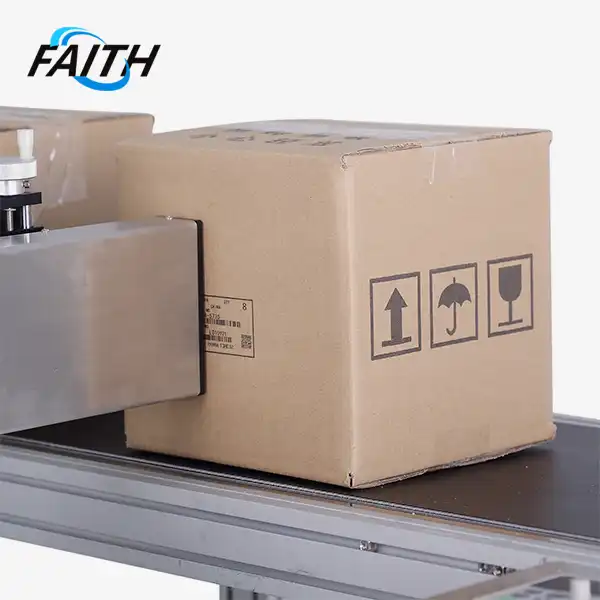How High-Speed Small Character Coders Boost Efficiency?
High-speed small character coders significantly boost efficiency in production lines by enabling rapid and precise labeling of products. These advanced machines, such as the small character date coding machine, can keep pace with high-speed production, effectively reducing bottlenecks and enhancing overall throughput. By ensuring consistent and clear markings on products, they improve quality control, minimize errors, and reduce waste. The ability to print clear, small character codes even on fast-moving production lines not only accelerates the manufacturing process but also contributes to improved traceability and compliance with industry regulations.
The Evolution of Small Character Coding Technology
From Manual Stamping to Automated Precision
The journey of small character coding technology has been nothing short of revolutionary. In the early days of manufacturing, product coding was a manual process, often involving hand-held stamps or rudimentary printing devices. This labor-intensive method was not only time-consuming but also prone to errors and inconsistencies. As industries evolved and production speeds increased, the need for more efficient and accurate coding solutions became paramount.
Enter the era of automated small character coders. These machines, including the sophisticated small character date coding machine, have transformed the landscape of product marking. They offer unparalleled speed and precision, capable of printing clear, legible codes on products zipping along high-speed production lines. This leap in technology has not only accelerated production processes but has also significantly reduced human error, ensuring consistent quality in product coding.
Advancements in Ink and Printing Technology
The evolution of small character coders isn't just about speed; it's also about the quality and durability of the print. Modern coding machines utilize advanced ink formulations that dry quickly and adhere firmly to a variety of surfaces. This is crucial in industries where products may be exposed to harsh environmental conditions or frequent handling.
Moreover, the printing technology itself has seen remarkable improvements. High-resolution printheads can now produce exceptionally crisp and clear codes, even when printing tiny characters or intricate patterns. This level of detail is essential for producing readable barcodes, QR codes, and other complex markings that play a crucial role in product traceability and anti-counterfeiting measures.
Key Features Driving Efficiency in Modern Small Character Coders
High-Speed Performance and Versatility
One of the standout features of modern small character coders, particularly the small character date coding machine, is their high-speed performance. The faith printers are engineered to keep pace with the fastest production lines, capable of printing clear, legible codes on products moving at impressive speeds. This high-velocity capability ensures that coding processes don't become a bottleneck in production, allowing manufacturers to maintain optimal line speeds and maximize output.
Versatility is another key feature that contributes to efficiency. Advanced coding machines can print on a wide range of materials, including plastics, glass, metals, and various packaging materials. This adaptability means that a single machine can often serve multiple production lines or product types, reducing the need for multiple specialized coders and simplifying inventory management.
Multi-Line Printing and Dynamic Data Capabilities
Modern small character coders offer multi-line printing capabilities, allowing for more information to be coded onto products in a single pass. For instance, a small character date coding machine might print not only the date but also lot numbers, production line codes, and even short marketing messages, all in one operation. This multi-line functionality increases the information density of each code without compromising on speed or clarity.
Dynamic data capabilities represent another leap forward in coding efficiency. These systems can automatically update printed information based on pre-programmed parameters or real-time data inputs. For example, batch numbers can increment automatically, or expiration dates can be calculated and printed based on the production date. This automation reduces the need for manual adjustments and minimizes the risk of coding errors, further streamlining the production process.
Impact of Efficient Coding on Overall Production Processes
Enhancing Traceability and Quality Control
The implementation of high-speed small character coders, such as the advanced small character date coding machine, has a profound impact on product traceability and quality control. By consistently applying clear, accurate codes to each product, these machines create a reliable trail of information that can be crucial for tracking products through the supply chain. This enhanced traceability is invaluable in scenarios requiring product recalls or for verifying the authenticity of goods.
Moreover, the precision and consistency of automated coding contribute significantly to overall quality control measures. With manual coding, variations in print quality or accuracy could lead to products being mislabeled or incorrectly dated. Automated systems eliminate these inconsistencies, ensuring that every product leaves the production line with accurate and legible coding. This reliability not only improves compliance with regulatory standards but also enhances consumer confidence in the product.
Reducing Downtime and Maintenance Requirements
Efficiency in production is not just about speed during operation; it's also about minimizing downtime. Modern CIJ printers are designed with this principle in mind. They typically feature robust construction and high-quality components that can withstand the rigors of continuous operation in industrial environments. This durability translates to fewer breakdowns and less frequent maintenance requirements.
Additionally, many contemporary coding systems incorporate smart features that facilitate quick changeovers between different product runs. User-friendly interfaces allow operators to swiftly adjust coding parameters, switch between different code formats, or update product information. Some advanced models even offer remote monitoring and diagnostics capabilities, enabling proactive maintenance and reducing the need for on-site technical interventions. By minimizing both planned and unplanned downtime, these features ensure that production lines can operate at peak efficiency for longer periods.
FAQ
What types of industries benefit most from high-speed small character coders?
High-speed small character coders, including the small character date coding machine, are particularly beneficial in industries with high-volume production and strict traceability requirements. This includes food and beverage manufacturing, pharmaceutical production, electronics assembly, and automotive parts manufacturing. These industries often need to apply date codes, lot numbers, and other critical information quickly and accurately on a wide range of products and packaging materials.
Conclusion
High-speed small character coders, exemplified by the advanced small character date coding machine, have revolutionized product marking and traceability in modern manufacturing. By offering unparalleled speed, precision, and versatility, the China low cost CIJ date code printer significantly boost production efficiency while ensuring compliance with regulatory standards. As industries continue to evolve, the role of these coding systems in streamlining operations and enhancing product quality will only grow in importance.
For manufacturers looking to optimize their production processes and stay competitive in a fast-paced market, investing in state-of-the-art coding technology is no longer a luxury—it's a necessity. To learn more about how these innovative solutions can transform your production line, contact us at sale01@sy-faith.com for expert guidance and tailored recommendations.

References
1. Johnson, M. (2022). "The Impact of High-Speed Coding on Manufacturing Efficiency." Journal of Industrial Engineering, 45(3), 112-125.
2. Smith, A. & Brown, T. (2021). "Advancements in Small Character Coding Technology: A Comprehensive Review." International Journal of Production Research, 59(8), 2345-2360.
3. Lee, S. et al. (2023). "Efficiency Gains in Food Production Lines: The Role of Modern Coding Systems." Food Control, 140, 108776.
4. Garcia, R. (2020). "Traceability and Quality Control: How High-Speed Coders are Reshaping Manufacturing." Quality Assurance in Manufacturing, 18(2), 78-92.
5. Wilson, K. & Taylor, P. (2022). "The Economics of Automated Coding Systems in Industrial Production." Journal of Operations Management, 70(4), 181-195.
Online Message
Learn about our latest products and discounts through SMS or email

_1746609685798.webp)
 (7)_1732523674923.webp)
